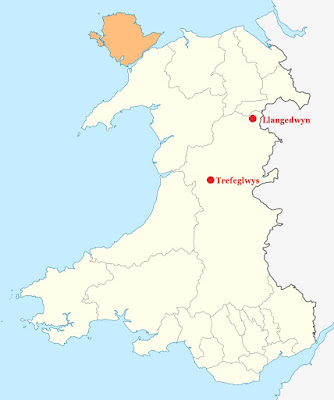Plotting Camlann: Letters from the Dead
Cedwyn, “from the world's blessing”, is listed among the seven survivors of the battle of Camlann in a 17th century manuscript. There is very little information available for St Cedwyn; he is absent from major accounts of the saints, such as David Farner’s Dictionary of the Saints and Elizabeth Rees Celtic Saints of Wales. However, we can only assume he was a warrior who in the aftermath of the slaughter at Camlann where both Arthur and Modred fell, he turned to religion and finished his days serving the sick and needy.
According to the Welsh genealogical tract Bonedd y Saint (Descent of the Saints) his mother was Madrun, a saint married to Ynyr Gwent, a prince of Caerwent and father of Caradog Freich Fras (Caradog strong arm) a contemporary of King Arthur. St Ceido was the fruit of the union of Madrun and Ynyr.
Madrun, or Madryn, is identified with St Materiana known for her church at Tintagel and also attributed with the foundation of a nunnery at Trawsfynydd in Merioneth. Madrun is said to be the daughter of Vortimer, who later married Gwgon Gwri (Gwgawn Gwrawn), son of Peredur son of Eliffer Gosgorddfawr (of the Great Army) and victor at the Battle of Arfderydd 573 AD, by whom she is said to have bore St Cedwyn. Clearly the chronology is not correct; this is far too late for Cedwyn to have been present at Camlann.
There seems to be some confusion here in the genealogies as the only historical Ynyr Gwent that can be positively identified is from the mid-6th century, around a hundred years after Vortimer, the son of Vortigern, would have lived. According to the 9th-century Historia Brittonum, Vortimer fought four battles against the invading Anglo Saxons in Kent and died shortly after the final battle. Vortimer’s floruit must have been mid-to-late 5th century with his battles in Kent mirrored in the Anglo Saxon Chronicle record of the advance of Hengest and his son Esc. Known as Gwerthefyr Fendigaid in Welsh (Vortimer the Blessed) he asked to be buried where the Saxons first landed as a talisman against further incursions. However, his request went unheeded by the Britons and the invaders soon returned.
 |
| Church of St Cedwyn, Llangedwyn, Powys. |
The foundation of the church at Llangedwyn in Montgoneryshire is attributed to St Cedwyn. Cedwyn’s chapel was said to have been in the Tanad valley near Llanrhaeadr-ym-Mochnant in North Powys, about 9 miles south-west of Oswestry, not far from the famous the Pistyll Rhaeadr waterfall, one of The Seven Wonders of Wales, at the foot of the Berwyn mountains. Claimed to have been founded in the 6th century the church at Llangedwyn was heavily restored in the 18th century.
There was also a Llangedwyn at Brecon, but now long lost, nearby the Cedwyn stream runs into the River Ely toward Cardiff. On the right bank of the Ely, is a wooded valley known as Cwm Cedwyn. According to Sabine Baring-Gould in The Lives of the British Saints, “the Cedwyn of Ynys Cedwyn in North Glamorgan, near the junction of the Twrch with the Tawe, is said to have been a giant”.
According to Terry Breverton in The Book of Welsh Saints, Llangedwen could have been at Trefeglwys in Montgomery. Apparently there is a dedication to Cedwyn in Montgomery and the saint’s presence here may be affirmed by the holy well Ffynnon Gedwen at Trefeglwys. Breverton cites his mother recalling the well being near a haunted house where children used to fill water bottles. He identifies this haunted house as “Dol Gau” where the sorcerer Ifan Huw claimed to have raised demons in the 18th century.
Next: St Pedrog from the strength of his spear
* * *


